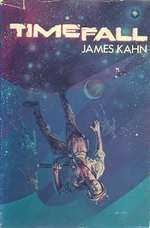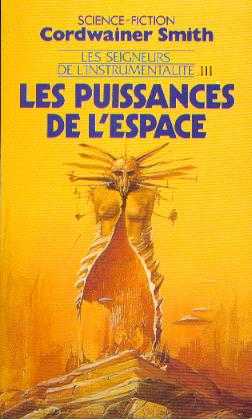|  
 
 | | | | 

| | Timefall
by James Kahn
First publication: Feb 1987

 This is the third book in Kahn’s New World trilogy, but the hero Joshua doesn’t know about the post-apocalyptic fantasy adventures of World Enough, and Time (Book I) and Time’s Dark Laughter (Book II). Could this be a prequel? Well, sort of. Time is cyclic and a previous version of Joshua has left him a message that leads Joshua of our world, wife of our world, and millionaire of our world to a lost city in the Amazon where the people think Joshua is their god arisen. Oh, and there are tunnels to different times and a circuitous but definite, supramundane possibility that the entire cyclical universe is going to end (or maybe never even exist in the first place). This is the third book in Kahn’s New World trilogy, but the hero Joshua doesn’t know about the post-apocalyptic fantasy adventures of World Enough, and Time (Book I) and Time’s Dark Laughter (Book II). Could this be a prequel? Well, sort of. Time is cyclic and a previous version of Joshua has left him a message that leads Joshua of our world, wife of our world, and millionaire of our world to a lost city in the Amazon where the people think Joshua is their god arisen. Oh, and there are tunnels to different times and a circuitous but definite, supramundane possibility that the entire cyclical universe is going to end (or maybe never even exist in the first place).

The 2014 release of the book includes new material. We hurried him into the den, plugged in the skull, gave him a demonstration on the wall, showed him the composite map we’d constructed: the rivers, the road, the city. We hurried him into the den, plugged in the skull, gave him a demonstration on the wall, showed him the composite map we’d constructed: the rivers, the road, the city. 
| |
| | | | |

 
 
 
 
 
 
 
 
 
 
 
 
 | | | |  | | ““Lui-même en Anachron””
by Cordwainer Smith
First publication: Les puissances de’espace, Sep 1987

 Tasco Magnon, time traveler, decides to take his new bride on his next trip through time—a quest to find the mythical Knot in Time, where the two of them get trapped and only one can return. Tasco Magnon, time traveler, decides to take his new bride on his next trip through time—a quest to find the mythical Knot in Time, where the two of them get trapped and only one can return.

After Smith’s death in 1966, the story was completed by his wife and sold to Harlan Ellison’s anthology The Last Dangerous Vision. In 1987, a translated version of the story was published in a French collection of Smith’s stories, so that the first published version was in French (although I have listed the English title above, since that’s how it was written). The English version was finally publisheded in Smith’s 1993 complete short science fiction collection by NESFA. By then, Ellison’s rights to the story had expired, although that didn’t stop him from suing NESFA. ‘Honeymoon in time,’ indeed. Why? Is it that your woman is jealous of your time trips? ‘Honeymoon in time,’ indeed. Why? Is it that your woman is jealous of your time trips? 
| |
| | | | |

 
 
The Time Guardian by John Baxter and Brian Hannant (Hannant, director), 3 Dec 1987
 When terminatoresque cyborgs attack a future Australian city (headed by Quantum Leap’s favorite scoundrel, Dean Stockwell, and defended by everyone’s favorite princess, Carrie Fisher), the scientists taken them all back in time—a fine plan until the evil cyborgs follow. When terminatoresque cyborgs attack a future Australian city (headed by Quantum Leap’s favorite scoundrel, Dean Stockwell, and defended by everyone’s favorite princess, Carrie Fisher), the scientists taken them all back in time—a fine plan until the evil cyborgs follow.

No Time Travel. Move along. |
The Year Before Yesterday by Brian Aldiss, 1987 [despite title, no time travel ]

“Enter a Soldier, Later: Enter Another” by Robert Silverberg, Asimov’s, Jun 1989 [simulacrum ]

“Left or Right?” by Martin Gardner, Mathenauts, Jun 1987 [4D spacial topology ]

“Traplanda” by Charles Sheffield, Asimov’s Science Fiction, Jun 1987 [despite appearances, no time travel ]

Dragonriders of Pern #8.1.A1: Dragonharper by Jody Lynn Nye, Jul 1987 [no time travel ]
aka A Crossroads Adventure in the World of Anne McCaffrey’s Pern: Dragonharper

| |     |